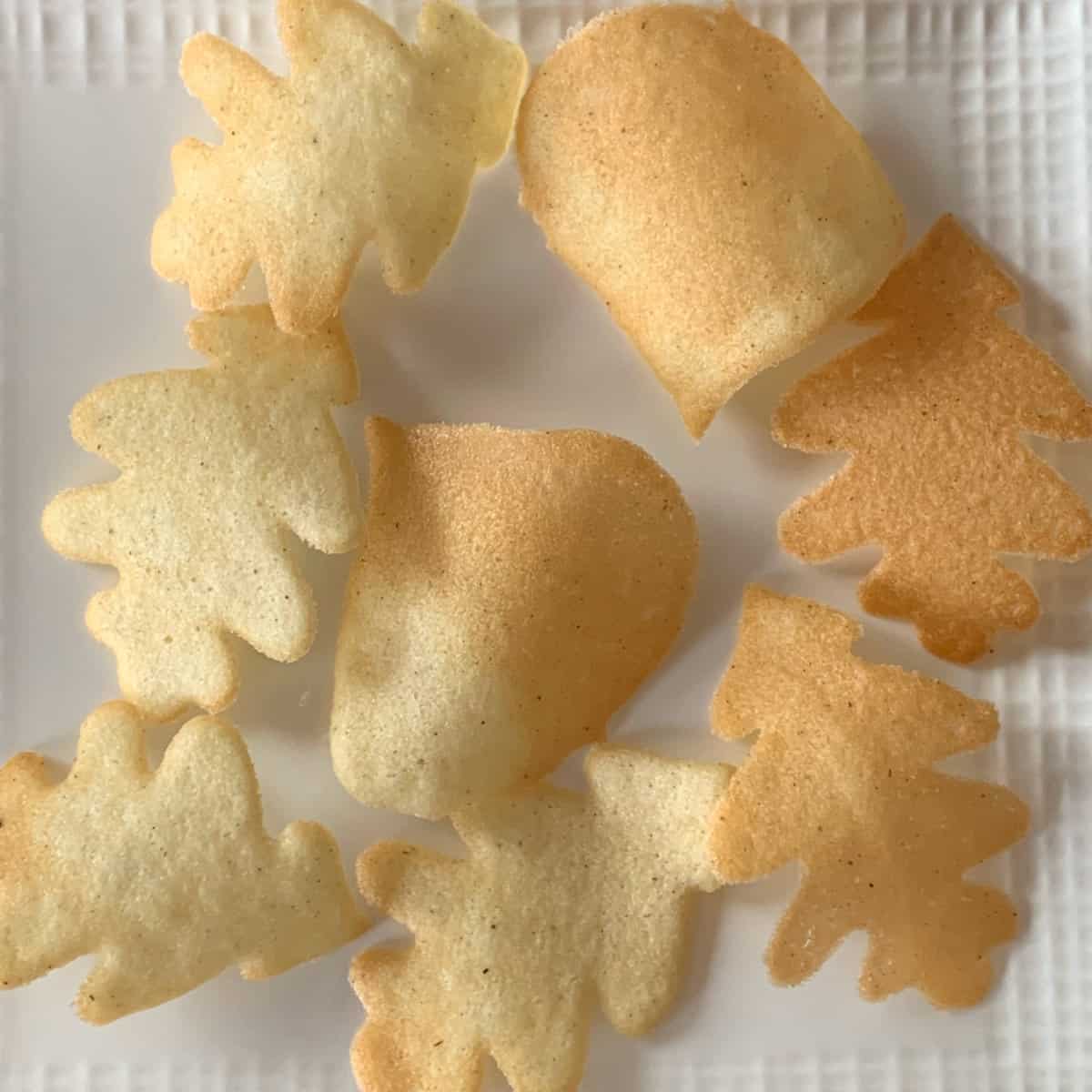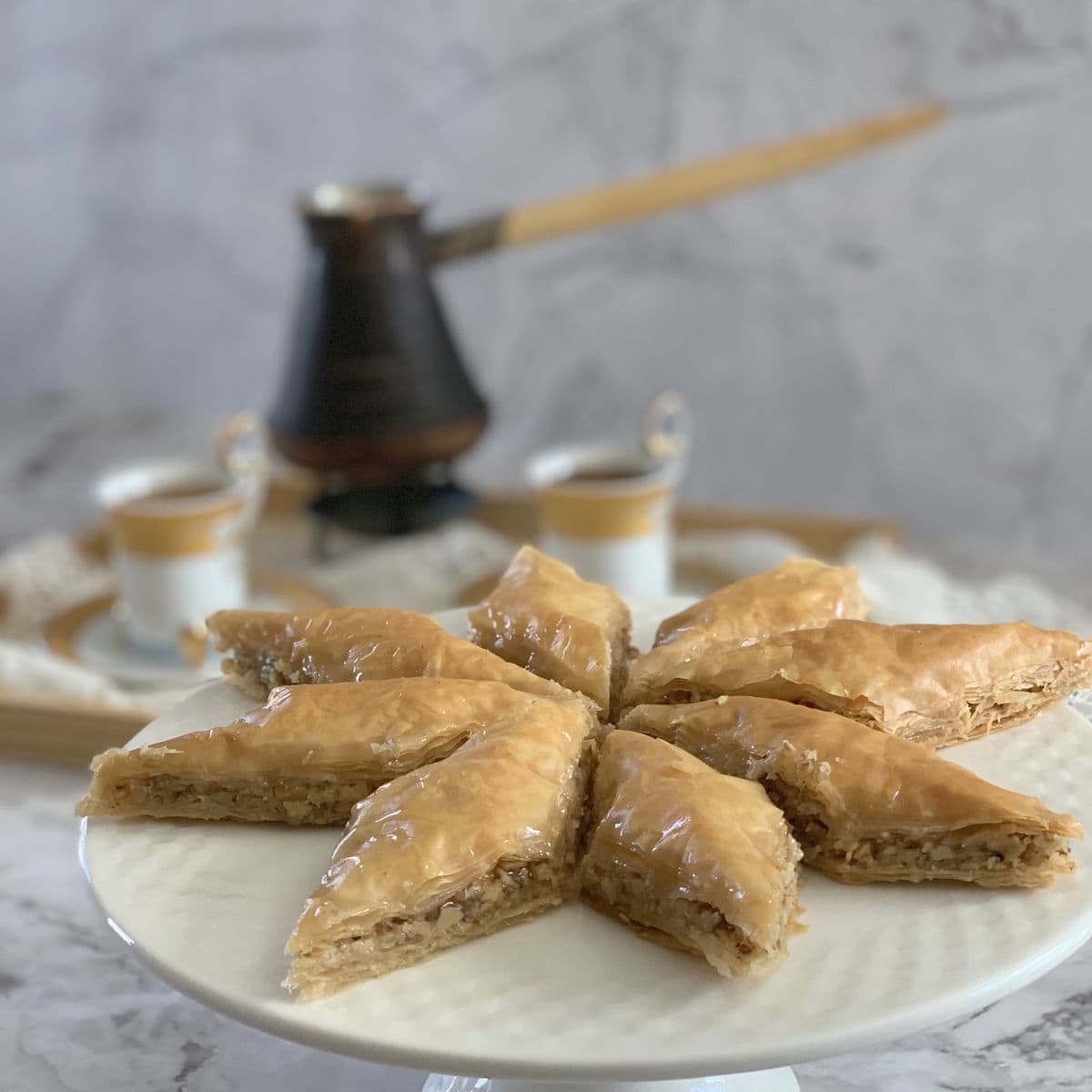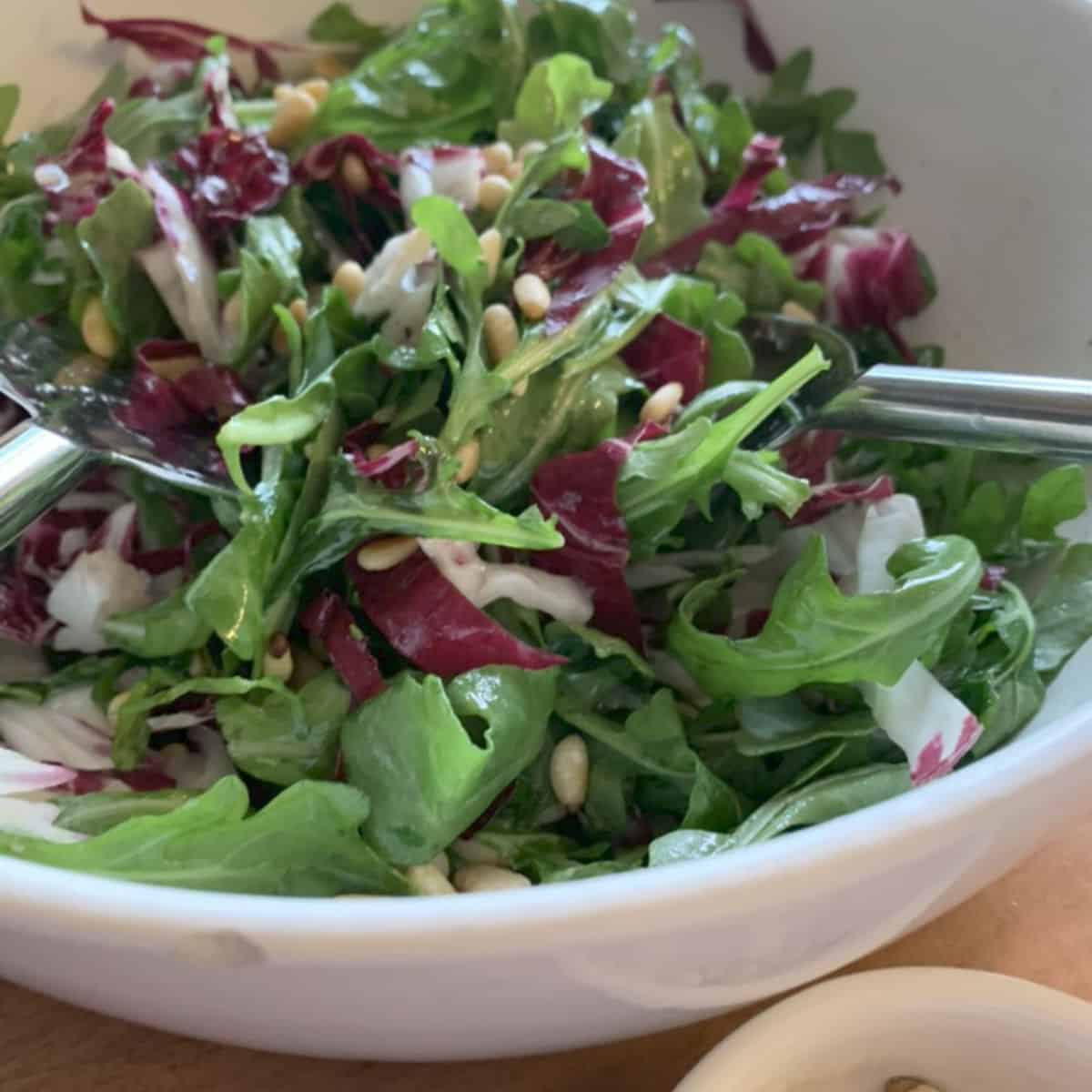Dobos Torte Recipe
The Dobos Torte and the Esterházy Torte are two iconic desserts that highlight the artistry of Hungarian and Austro-Hungarian confectionery. While the Dobos Torte is famed for its caramel-topped sponge layers and creamy chocolate buttercream, the Esterházy Torte offers a nutty indulgence with layers of hazelnut dacquoise and rich buttercream. Both cakes are show-stopping classics, perfect for those who appreciate elegant presentations and decadent flavors in their desserts. Trying one will certainly inspire you to savor the other!
The Dobos Torte became a sensation in Europe in the late 19th century, but this show-stopping cake can still be the star of today’s celebrations. Join me on a journey as I guide you step-by-step to create this elaborate, yet stunning cake right in your own kitchen.

Table of Contents
Chronicles of Dobos Birthday Cake
Once more, my mom and I paired up to create another elaborate cake. This time we decided to make a Hungarian cake for my son’s birthday. A globe apart, in different hemispheres, two different kitchens, we came together to have fun, create and celebrate.
We started this sort of mother-daughter throw-down a while back and completed several challenges like that.
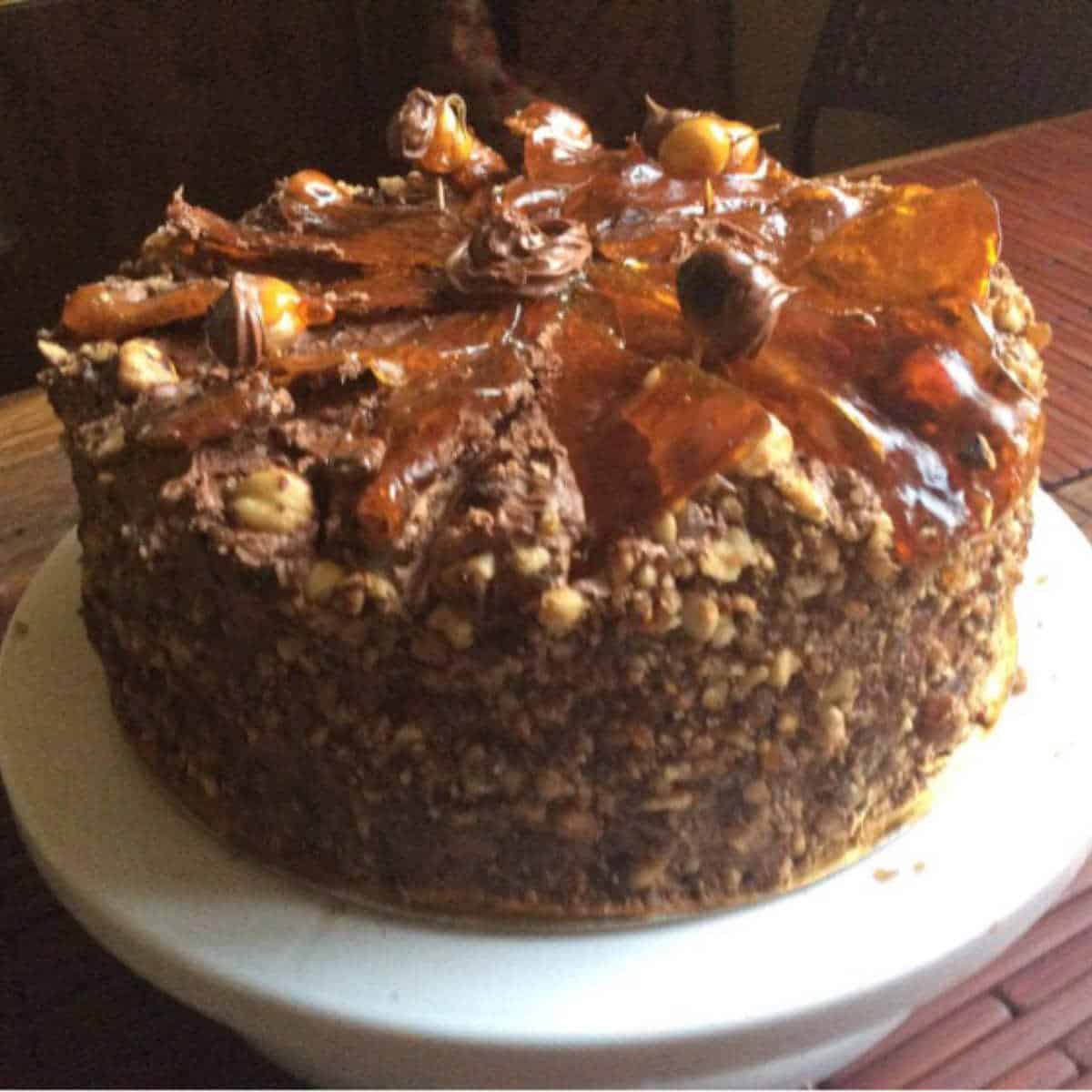

First and foremost I got my inspiration from the Kaffeehaus: Exquisite Desserts from the Classic Cafés of Vienna, Budapest, and Prague by Rick Rodgers.
I also watched Ann Olson’s video on Dobos torte, where she bakes this iconic cake so elegantly and effortlessly.
I also want to inspire you to create this elaborate yet gorgeous cake.
What’s unique about this Recipe?
Grocery and Pantry List
Time Required:
Bake in 425°F (220°C) preheated oven.
Special Tools to Use:
Recipe Steps at a Glance
This recipe can be broken down into the following steps:
Step-by-step: How to Make
Step 1: Preparing the pans
Set your oven to 220°C (425°F) to ensure it reaches the right temperature by the time you’re ready to bake.
Have ready an cake pan with an 8-inch (20cm) diameter.
Use this cake pan to draw an 8-inch circle on six separate pieces of regular paper. These circles will serve as guides for your cake layers.
Place a sheet of parchment paper on each of your baking trays.
Slide the papers with the drawn circles underneath the parchment paper on each tray. This will help you evenly spread the batter within the circles.
You will need three baking sheets to accommodate the six cake layers. You can bake two layers on each sheet.
Step 2: Making sponge cake
In a stand mixer, add the egg whites and sprinkle with the cream of tartar. Start to whip the egg whites to soft peaks using the whisk attachment.
Gradually add the sugar and continue to whip to medium peaks.
Transfer the whipped egg whites to a clean bowl and set aside.
In the same bowl of a stand mixer with the whisk attachment, beat the egg yolk with 50g sugar and vanilla extract until pale and thick, about 4-5 minutes until it doubles in volume and is pale yellow.
Using a rubber spatula, fold one-third of the egg whites into the yolk mixture.
Gently fold in the remaining egg whites until fully incorporated. Avoid over-mixing.
Sift and fold in the flour until just combined.
In a separate bowl (using the same bowl from the egg whites) combine half a cup of the batter and the melted butter. Add this back into the mixture.
Pipe the batter on the prepared parchment paper, using the circles as a guide.
Bake the layers for 5 minutes, until light golden brown.

Using the spring-form pan (or any other 8-inch ring) trim the edges of the layer so they are even and perfectly round.
At this stage you can store the layers by stacking them up on each other with parchment papers in-between.
Step 3: Making chocolate buttercream
Melt the chocolate either in the microwave or over the bain-marie. Set it aside to cool.
Combine the egg yolks with a quarter cup of sugar and whisk on high speed until light and fluffy.
In a sauce pan, combine the rest of the sugar with a tablespoon of water and a teaspoon of corn syrup.
Bring the sugar to a boil until it reaches 238°F (115°C).

Slowly pour the hot syrup down the side of the bowl into the whipped egg yolk while the mixer is running. Continue whisking until the mixture cools down to room temperature.
Once the egg mixture is cool to the touch, add the room temperature butter piece-by-piece until fully incorporated.
At this point the chocolate mixture should be cool enough to add to the buttercream.
Beat the buttercream until smooth and velvety and refrigerate until ready to assemble the cake.
Step 4: Caramel crown and praline
Have everything ready before you cook the caramel.
Make the caramel by adding the cup of sugar and 2 tablespoon water and a tablespoon of corn syrup. Boil it on high heat until it develops an amber color which is typically at 375°F (195°C).
There are two option of making caramel crown. You will need to reserve half of the caramel for the praline.
Option 1

Line a wooden cutting board with parchment paper and arrange an oiled tart ring on it.
Pour about the half of the caramel into the prepared ring.
Wait a few seconds and carefully remove the ring and score and then cut the caramel disk into 12 wedges while it is still soft. It will easily break into individual wedges once it’s cool. Set aside.
Option 2

Line a wooden cutting board with another parchment paper and one of the sponge layers on it.
Pour about half of the caramel on top of the cake layer.
Score and cut the caramel covered layer into 12 wedges. Set aside.
Making praline
Line the baking sheet with parchment and spread the hazelnuts on top. Drizzle the saved caramel on the hazelnuts and let them cool down.
Break the caramel covered hazelnuts and put them in a food processor. Pulse for a few times until they are courtly grinds.
Step 5: Assembling the cake

Have all the components ready for the assembly. Bring the cake layers and buttercream to room temperature if previously chilled.
Arrange the first layer on a cake board and spread the thin layer of buttercream on top. Alternate the layers: sponge and buttercream. Cover assembled cake with the remaining buttercream (both sides and the top.)
Sprinkle the praline on the sides of the cake, press gently until they adhere to the sides.
Evenly arrange the hazelnuts on the edges of the top of the cake.
Pointing to the center, arrange the caramel wedges on the cake in an angle and rest them on the hazelnuts.
Add any additional decoration if you like.

Decorating and serving the Dobos torte

Tips and Wisdom from Cafe Osharak
Frequently Asked Questions
Where did the Dob0s cake come from?
The cake was a novelty in it’s time. Five thin layers of sponge cake, sandwiched with chocolate buttercream and domed with caramel glaze. After the Hungarian debut, the cake became famous in all capital cities in Europe. The caramel coating gave the cake a longer shelf life. Dobos made specially designed wooden boxes; and soon the cake made its way across Europe.
The recipe itself, however, was a mystery for a year until Dobos finally handed over the original recipe to the Metropolitan Confectioner and Gingerbread Industry Association, on the condition that any member of the industry association was free to use it.
Today, Dobos Torta is known all over the world, with 100 derivations. In 2017, a ministerial decree in Hungary defined the shape and composition of the cake: the cake should be circular and have five sheets. The Dobos Sheet and Dobos Cream are nearly equal in thickness to sponge cake and buttercream. The top of the cake has a golden brown caramelized sugar roof.
Who was Jószef Dobos?
He was a culinary aficionado and gastronomic impresarios of Belle Epoch Hungary.
He was beloved in his own country; in particular Budapest. His culinary book Hungarian-French Cookbook published in 1881 served as a manual for chefs and home cooks around Europe for years.
In 1895, queen Elisabeth and Franz Joseph were the first to give a royal and glorious endorsement to this cake at the first General National Exhibition.
More Recipes to Try From Cafe Osharak
If you’re intrigued by unique flavor pairings in layered cakes, the Smetannik Sour Cream Walnut Cake is another must-try for its distinctive sour cream frosting and walnut layers.
And be sure to check out other recipes from Cafe Osharak that you might enjoy!
Dobos Torte
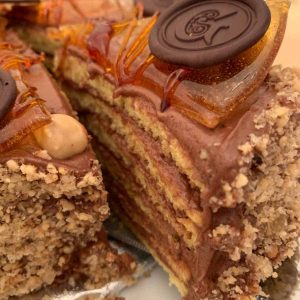
Ingredients
Sponge Batter
- 6 egg whites large
- 1/8 tsp cream of tartar
- 50 g granulated sugar
- 6 egg yolks large
- 1 teaspoon vanilla extract
- 50 g granulated sugar
- 100 g cake flour
- 30 g unsalted butter melted
Chocolate Buttercream
- 100 g semisweet chocolate
- 5 egg yolks
- 120 g granulated sugar
- 1 teaspoon corn syrup
- 170 g unsalted butter
- 1 tsp vanilla extract
Caramel
- 200 g granulated sugar
- 50 ml water
- 30 g corn syrup
Praline
- 1/2 cup hazelnuts toasted and peeled
Decorations
- 50 g semi-sweet chocolate
- 8 hazelnut
Instructions
Prep
- Preheat the oven to 220°C (425°F).
- Using a cake pan draw an 8-inch (20cm) circle on six pieces of regular paper. Line the baking tray with the parchment, and slide the papers underneath the parchment. You will need three baking sheets to make 6 layers.
- Measure all the ingredients so they are ready.
Sponge cake
- In a stand mixer, add the egg whites and sprinkle with the cream of tartar. Start to whip the egg whites to soft peaks using the whisk attachment.6 egg whites, 1/8 tsp cream of tartar
- Gradually add the sugar and continue to whip to medium peaks.50 g granulated sugar
- Transfer the whipped egg whites to a clean bowl and set aside.
- In the same bowl of a stand mixer with the whisk attachment, beat the egg yolk with 50g sugar and vanilla extract until pale and thick, about 4-5 minutes until it doubles in volume and is pale yellow.6 egg yolks, 1 teaspoon vanilla extract, 50 g granulated sugar
- Using a rubber spatula, fold one-third of the egg whites into the yolk mixture.
- Gently fold in the remaining egg whites until fully incorporated. Avoid over-mixing.
- Sift and fold in the flour until just combined.100 g cake flour
- In a separate bowl (use the same bowl from the egg whites) combine half a cup of the batter and the melted butter. Add this back into the mixture30 g unsalted butter
- Pipe the batter on the prepared parchment paper, using the circles as a guide.
- Bake the layers for 5 minutes, until light golden brown.
- Using the spring-form pan (or any other 8-inch ring) trim the edges of the layer so they are even and perfectly round.
- At this stage you can store the layers by stacking them up on each other with parchment papers in-between.
Chocolate Buttercream
- Melt the chocolate either in the microwave or over the bain-marie. Set it aside to cool.100 g semisweet chocolate
- Combine the egg yolks with quarter cup of sugar and whisk in on high speed until light and fluffy.5 egg yolks, 120 g granulated sugar
- In a sauce pan, combine the rest of the sugar with a tablespoon of water and a teaspoon of corn syrup.1 teaspoon corn syrup
- Bring the sugar to a boil until it reaches 115 °C (238°F).
- Slowly pour the hot syrup down the side of the bowl into the whipped egg yolk while the mixer is running. Continue whisking until the mixture cools down to room temperature.
- Once the egg mixture is cool to the touch, add the room temperature butter piece by piece until fully incorporated.170 g unsalted butter, 1 tsp vanilla extract
- At this point the chocolate mixture should be cool enough to add to the buttercream.
- Beat the buttercream until smooth and velvety and refrigerate until ready to assemble the cake.
Caramel crown and praline
- Have everything ready before you cook the caramel.
- Line the baking sheet with a parchment and pile the hazelnuts on top.
- Option 1: Line a wooden cutting board with another parchment paper and arrange an oiled tart ring on it.
- Option 2. Line a wooden cutting board with another parchment paper and one of the sponge layers on it.
- Make the caramel by adding the cup of sugar and 2 tablespoon water and a tablespoon of corn syrup. Boil it on high heat until it develops an amber color.200 g granulated sugar, 30 g corn syrup, 50 ml water
- Pour about the half of the caramel into the prepared ring (option1) or on top of the cake layer (option 2).
- The rest of the caramel drizzle on the hazelnuts.
- For option 1: Remove the ring and score and then cut the caramel disk into 12 wedges. Set aside.
- For option 2: Score and cut the caramel covered layer into 12 wedges. Set aside.
Praline
- Break the caramel covered hazelnuts and put them in a food processor. Pulse for a few times until they are courtly grinds.1/2 cup hazelnuts toasted and peeled
Assembling the cake
- Have all the components ready for the assembly. Cake layers Buttercream – bring to a room temperatureCaramel wedgesPralineDecorations8 hazelnut
- Arrange the first layer on a cake board and spread the thin layer of buttercream on top. Alternate the layers sponge and buttercream. Cover assembled cake with the remaining buttercream both sides and the top.
- Sprinkle the praline on the sides of the cake, press gently until they adhere to the sides.
- Evenly arrange the hazelnuts on the edges of the top of the cake.
- Pointing to the center, arrange the caramel wedges on the cake in an angle and rest them on the hazelnuts.
- Add any additional decoration if you like.
- For this cake I melted the chocolate and made monogram initial coins with the letter G.50 g semi-sweet chocolate



